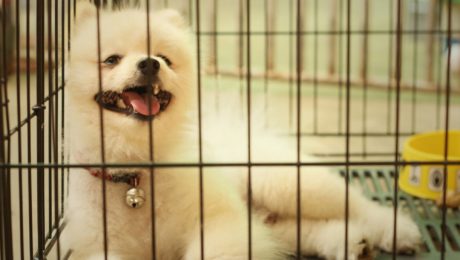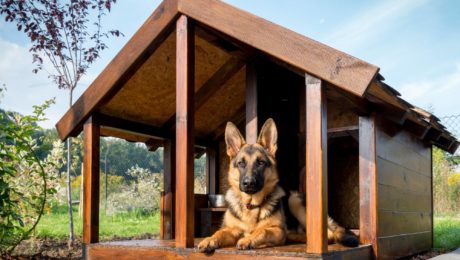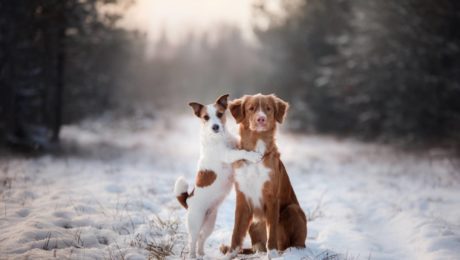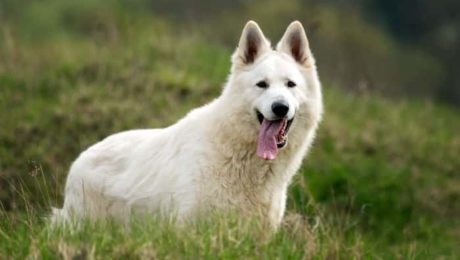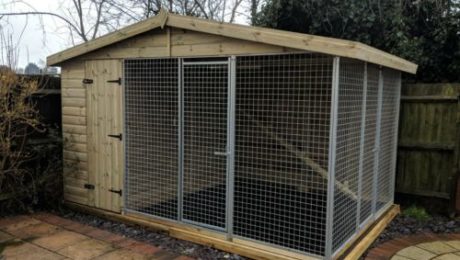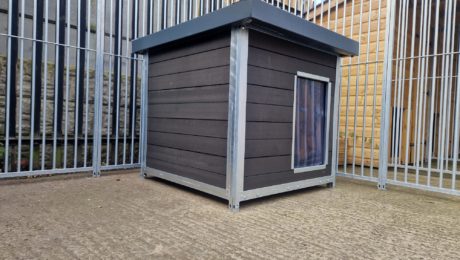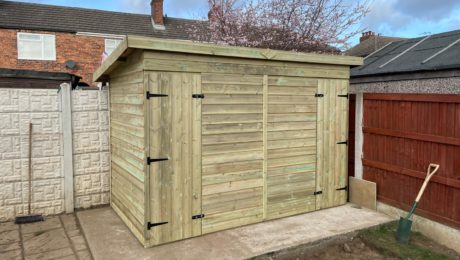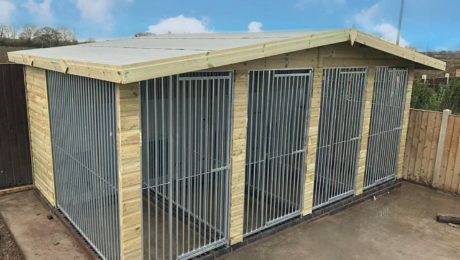Why Every Dog Deserves Their Own Space: The Benefits of Single Dog Kennels
There are over 13 million pet dogs owned across the country. Dogs are a man’s best friend and therefore they deserve the best! Dogs benefit from having their own safe space where they can sleep, play and relax.
Dog kennels provide privacy and comfortable space for your dog. There are many options available on the market that will suit your budget and provide for the needs of any dog.
Here are some reasons why dogs deserve a dog kennel.
Security and Comfort
Dogs are den animals by nature, and having a designated space gives them a sense of security and comfort. A kennel provides protection from exposure to harsh weather, ensuring your dog has a safe environment to rest in.
A well-designed kennel can provide outside access for your dog while keeping him safe. Add a bed and toys to keep your dog stimulated and happy while staying in the kennel.
Stress Relief
Dogs experience stress and anxiety, just like humans. Having their own space acts as a retreat from overwhelming situations or loud noises and surroundings. Sensitive or anxious dogs will benefit greatly from having their own private space.
A kennel also offers weather security, which can help decrease your furry friend’s anxiety.
Training and Behaviour Management
Dog kennels can be used as a tool for training and behaviour management. When properly introduced and used positively, a kennel can help you in various ways, including:
- Being used as a training aid
- Teaching dogs to associate it with positive experiences
- Encouraging good behaviour
- Help you to house train your pet
It can also be used for managing separation anxiety and preventing destructive behaviour when unsupervised.
Health and Safety
Kennels offer a controlled and contained space for dogs. The boundaries of the kennel protect dogs from dangerous areas.
A dog kennel is useful during illness or recovery from surgery, as it restricts movement and allows for proper rest and recuperation.
Cleanliness and Hygiene
Kennels promote hygiene and cleanliness. They provide a confined area where dogs can eat and sleep, making it easier to prevent accidents or messes in the house.
Use removable food trays and easy-to-clean surfaces in the kennel.
Personal Space
Dogs need personal space but also boundaries. Having their own kennel allows for an established sense of ownership and territory and gives them a designated area for themselves.
This can be important in multi-dog households, where individual dogs may require separate spaces to avoid conflicts or resource guarding.
Pets Deserve Dog Kennels
Dog kennels ensure a quality experience for your dog and you can tailor the design to your dog’s needs. Your dog needs exercise, mental stimulation, and quality time with their owners. A kennel does not replace this but adds to the overall quality of life for your companion.
If you’re looking for a quality dog kennel for your furry friend, contact us today! We are a leading dog kennel manufacturer and distributor.
- Published in Blog
Kennel Training Tips for Your Furry Friend
According to the World Animal Foundation, more than half of the adults living in the UK own a pet. About 27% of these pets are dogs with about 13 million dogs living in the UK.
If you recently brought home a new dog, you should look into providing your four-legged friend with a kennel. One of these single dog kennels would be a fantastic option for your dog. They’re the best types of kennels for those with just one dog living in their homes.
But you won’t be able to simply put a dog into a kennel and expect them to know what to do right away. To make the most of the benefits of kennels, you’ll need to train your dog so they react in the right way when you put them into a kennel.
Are you ready to put a kennel training routine into place for your new dog? Here are tips that’ll help you get the job done.
Learn About the Benefits of Kennels for Dogs
Some people don’t automatically love the idea of using single dog kennels for their new dogs. They don’t like the thought of putting their dogs into outdoor kennels as opposed to allowing them to stay inside with them.
But you should know there are many benefits of kennels for dogs. Here are several of the biggest benefits that’ll come along with using one of the many types of kennels:
- They make dogs feel safer than they would otherwise
- They provide dogs, especially smaller ones, with the protection they need from other animals, large birds, etc.
- They set dogs up with great places to play
- They let dogs kick back and relax and steer clear of stressful situations
- They give you peace of mind when your dog is outside
As you can see, it’ll make a lot of sense for you to shop for single dog kennels and pick one out. Even if you aren’t attracted to the idea of doing it right away, it shouldn’t take you too long to come around to it.
Shop Around for Single Dog Kennels
Once you know about the benefits of kennels for dogs, you can start shopping around for single dog kennels. You’ll find a large selection of single dog kennels you can choose from through a company like Benchmark Kennels.
Benchmark Kennels sells wooden dog kennels, eco thermal dog kennels, and more. They also sell single dog kennels that have almost any dog kennel features you could ever imagine.
Your goal should be to track down the right dog kennel size. The kennel you choose should fit comfortably onto your property while also providing your dog with plenty of space to stretch out.
You should also compare the dog kennel features and look for the best-priced kennels around. It’ll help you land on a single dog kennel that’ll fit nicely into your budget.
Pick the Right Place to Put a Dog Kennel
After you invest in one of the best single dog kennels in the business, you can have it delivered to your home so that you can get it all set up. It’ll be extremely important for you to pick the best possible place to put it depending on the dog kennel size.
Ideally, you should strategically place a single dog kennel in a place that’ll make it easy to see from inside your house. You should also choose a location that isn’t tucked away in a dark corner that might scare your dog.
The place you pick for a dog kennel could make or break your whole kennel training routine. It’s why you shouldn’t just choose the first place you can find. You’ll want to consider several options before going with the best one.
Let Your Dog Get Acquainted With a Kennel
When you have a single dog kennel all set up, you might be tempted to put your new pup right inside of it and close the gate behind them. But this is not the right approach to take if you want your dog to fall in love with its new quarters.
Instead, you should very slowly introduce your dog to their new kennel and let them get acclimated to it. Walk around inside the kennel with them and allow them to sniff around so they’re able to familiarize themselves with the kennel.
You might even want to go as far as to toss treats in your dog’s direction when they first enter the kennel. This will have them associating their kennel with nothing but good things before long.
Whatever you do, don’t make it seem as though putting your dog into a kennel is going to be punishment for them. This will make the kennel training routine drag out for so much longer than it should.
Make Your Dog Feel Right at Home in a Kennel
From the moment your dog first sets foot in their new kennel, you want it to feel like home to them. How can you accomplish this goal? Here are just a few ideas:
- Put your dog’s favourite blanket or towel inside the kennel
- Set up several of your dog’s favourite toys inside the kennel
- Give your dog a bone or another special treat inside the kennel
Whatever you can do to make your dog feel at peace in a kennel will work wonders for your kennel training routine. In some cases, you might even find that your dog will want to stay in a kennel right from the start.
Begin Feeding Your Dog in a Kennel
If you reach this point and your dog still isn’t 100% sure about the kennel, you should spend time going through each of the steps we’ve listed again. You might want to spend a few days or even a full week working to introduce your dog to a kennel so that they feel comfortable in it.
Once they appear to be less anxious about going into a kennel, you can welcome food into the mix. You can begin to feed your dog some or even all of their meals in a kennel.
At first, you might want to leave your dog’s bowl filled with food right by the door to a kennel and leave the door open. It’ll give your dog a chance to get used to eating meals in a kennel.
But as time goes on, you should move your dog’s bowl further and further away from the door for a kennel. You should also begin closing a kennel’s door and letting a dog hang out for a little while after they’re done eating.
Initially, your dog might only want to stay in a kennel for five or ten minutes at a time. If they start whining, you should let them out of the kennel so that they don’t start associating a kennel with being locked up.
You should, however, start to see your dog warm up to the idea of being in a kennel. Before long, you may see them playing in a kennel and even lying down to rest in it.
Start Leaving Your Dog in a Kennel for Longer Stretches
At first, your dog isn’t going to want to stay in a kennel for long periods of time. But as time goes on, you’ll want to make it your mission to start leaving your dog in a kennel for longer stretches.
In a perfect world, you’ll want to work your way up to leaving your dog in a kennel for 15 minutes, then 30 minutes, then 45 minutes, and then an hour without them crying at any point.
This is going to take a lot of patience on your part. There will be days when your dog will get into a kennel without you having to ask and hang out in it for hours on end. There may also be other times when your dog will refuse to get into a kennel or get in only to ask to be let back out five minutes later.
Work with your dog to make them feel as comfortable as possible in a kennel. This may require you to check on them every so often so that they know you haven’t gone far and will be back to get them.
Teach Your Dog to Go to a Kennel on Your Command
There are so many commands you’ll want to teach your dog when you first bring them home. From “Sit!” to “Heel!”, you should aim to teach them these commands as quickly as possible since it can be difficult to teach an older dog to abide by them.
You should also make it a point to teach your dog a phrase like, “In your kennel!” Start saying it to them as soon as they begin spending their fair share of time in a kennel.
You want to be able to tell your dog to go into their kennel and have them listen to you. This is going to call on you to make their kennel sound like an attractive option while also teaching them a command related to it.
Leave Your Dog in a Kennel When You’re Not Home
When you hit this point in your kennel training routine, your dog should be used to spending long stretches of time in a kennel. You’ll be free to turn up the intensity a little to see what your dog can do.
Start leaving your dog in a kennel when you have to leave home to run out for a little while. Put them in the kennel about ten minutes before you need to leave to make sure they’re okay with being in it. Then, head out and hope for the best.
You might be filled with anxiety the first few times you do this. But after several trips out with your dog in a kennel, you’ll see that they’re going to be just fine.
Just make sure you try not to rile your dog up too much when you come back home. By doing this, you might inadvertently send the message that the kennel is a bad place to be. You obviously don’t want to make it seem this way at all.
You’ll be better off making a subtle return home. You can go to see your dog in the kennel and let them out if they’re interested in coming out to get a closer look at you.
Avoid Leaving Your Dog in a Kennel All the Time
In the coming weeks, months, and years, your dog is going to spend a lot of time in a kennel. But you should steer clear of leaving them in a kennel all the time.
Even if your dog loves their kennel, you will still want to let them come out and run around. You’ll also want to let them inside to hang out with you and your family.
Any time your dog isn’t in their kennel, you should see to it that the kennel gets cleaned out. You’ll want to pick up dog poop and any other debris that might build up in the kennel.
By doing this, you’ll ensure that your dog will want to return to the kennel later on. You’ll also guarantee that your dog is able to stay happy and healthy when they’re in their kennel.
Search For the Best Single Dog Kennel Here
Would you like to enjoy the benefits of kennels for yourself and work on establishing a kennel training routine for your dog? Benchmark Kennels can provide you with plenty of options when it comes to single dog kennels.
We also carry a wide range of other types of kennels for dogs. They come in just about every dog kennel size and have all the dog kennel features you and your furry friend will want.
Shop around for single dog kennels on our website and reach out to us with any questions you may have.
- Published in Uncategorised
What Your Dog Needs in Their Kennel: Keeping Your Pet Warm in Winter, Cool in the Summer, and Comfortable All the Time
Roughly 50% of all households in America own a dog. Dogs are extremely popular pets, their personalities and demeanor making them great additions to any family. But when you own a dog, you have a responsibility to ensure they’re happy and healthy.
If you’re keeping your dogs outside, you need to make sure they’re comfortable in any weather situation. This is where single-dog kennels come into play. The best way to ensure your dog is safe is to give them their own space to retreat to.
So keep reading to find out how you can create a comfortable dog kennel that will keep your pup happy year-round.
Moderate the Temperature of the Dog Kennel
An easy way moderate the temperature of single-dog kennels is to make sure the kennel is in a good position. During summer, move the kennel to a shady or covered area so that it does not overheat.
In wintertime, elevate the kennel from the ground. If there is no direct contact with cold surfaces below, the cold cannot penetrate the floor of the kennel readily. You can also use carpet off-cuts or blankets to cover the floor to keep the cold out.
Plastic sheeting can be nailed to the walls and floor to add to the insulation of the kennel. If you want to splurge, invest in insulation sheeting that is available at building stores. Weatherboard the outside of the kennel to ensure it stays dry during the rainy season.
Add Ventilation
Proper ventilation is important in all weather conditions. Good airflow helps prevent the buildup of stale air, reduces odors, and regulates temperature. Ensure the kennel has windows, vents, or openings that allow fresh air to circulate but still protect your dog from the weather.
Size and Room to Move
Make sure the kennel is the right size for your dog. They should be able to stand, turn and stretch comfortably.
Think about dog behavior, they usually turn around in circles, scratch at their bedding, and maybe even stretch before they are ready to lie down. The right size kennel will allow your dog to do all of this before he plunks down on his bed.
Do not overcrowd the kennel and keep to the kennel accessories he needs and loves. Also, consider which kennel supplies you might want to store with them as you’ll need to make sure there’s enough room.
Comfortable Bed and Bedding
Choose bedding that is soft and provides cushioning. Avoid materials that retain moisture or could be harmful if ingested.
Dog beds come in many different shapes and sizes. It is important that the bed must be the right size as dogs sleep in different positions.
They like to
- Stretch out
- Curl up
- Lay on their backs
- Lay on their bellies with legs stretched out
Their bed must be large enough for them to be able to lie comfortably in all these natural positions.
Here are some options to choose from:
Raised Beds
Raised or elevated beds are great for dogs who like some airflow or dogs that enjoy a firmer sleeping surface. These beds have a sturdy frame with a mesh or durable fabric surface, that keeps the dog off the floor and provides ventilation.
For dogs who love to chew, an elevated bed with woven material and a metal frame is a good choice as they are chew and claw-proof.
These beds are also suitable for sturdy dogs as their frames and covering will support the weight of larger dogs. Check the weight specifications and choose one that will suit your dog.
Orthopedic Beds
These beds are ideal for older dogs or dogs with joint or muscle issues. They provide support and cushioning with memory foam or other specialized materials that conform to the dog’s body shape, relieving pressure points.
A senior dog will love a soft blanket that rests on a firm surface that conforms to his body and is easy to reach from the ground.
Donut or Bolster Beds
These beds have raised edges all around that create a cozy and secure space for dogs to curl up in. They offer a sense of comfort and a place to rest their heads.
Pillow Beds
Pillow beds are simple, rectangular beds filled with a soft material. They’re a staple when it comes to creating a comfortable dog kennel.
They provide a surface for dogs to stretch out or lie down. If covered in a durable material they will serve your dog well for a long time.
Cooling Beds
They are made by using cooling materials or gel-infused foam and are suitable for use in warmer climates or by dogs prone to overheating. The cooling properties help regulate the dog’s body temperature and provide relief.
Nest Beds
Nest beds are similar to donut beds but have higher walls. They offer a cozy, nest-like feel that many dogs love. These beds provide a sense of security and can be particularly appealing to small or anxious dogs.
More than one dog? To avoid competition, you’ll need one bed per dog. If your dogs enjoy snuggling, consider getting an additional dog bed large enough for them to comfortably share.
Single-Dog Kennels for Your Furry Friends
When it comes to keeping dogs outside you should consider getting single-dog kennels for your pups and any necessary kennel supplies. This not only gives them a comfortable space to retreat to that’s all their own, but it’s also a great way to keep your dogs safe. Just because you have outdoor kennels doesn’t mean you can’t create a cozy space that keeps them cozy year-round.
If you’re interested in getting single-dog kennels and unsure where to start, you can contact us today. At Benchmark Kennels we specialize in outdoor kennels and kennel accessories your pets are sure to love.
- Published in Blog
Why Do Working Dogs Need an Outdoor Kennel?
Why Do Working Dogs Need an Outdoor Kennel?
Did you know there are thousands of working dogs living throughout the UK right now? Unlike other types of dogs, working dogs don’t spend their days indoors, cosied up on couches catching up on sleep. As their name suggests, they’re outside performing specific tasks they’re trained to do.
Some working dogs, for example, are hunting dogs that help hunters retrieve birds and more on hunting adventures. Others work on farms and lend a hand to farmers who need help wrangling their herds. Whatever the case, working dogs can benefit from single-dog kennels. You might not automatically think to keep working dogs outside in a since they’ll already spend so much time outside of the house. But it could provide them with the best living conditions possible.
Here are several reasons why working dogs should have access to single dog kennels.
Provides Working Dogs With Rest
Working dogs obviously spend a lot of their time, well, working. So they need to get plenty of rest when they’re off the clock. Keeping working dogs outside in an outdoor dog kennel gives them the space they need to spread out and relax. Even when the weather isn’t ideal, wooden dog kennels will still provide the perfect living conditions.
Working dogs won’t have to worry about humans and other pets bothering them when they have their own spaces. It’s one of the best reasons to invest in single dog kennels.
Keeps Working Dogs Primed and Ready to Go
Most working dogs live to work. They’re at their happiest when they’re working side-by-side with their owners to complete necessary tasks. With this in mind, putting working dogs in single-use kennels might seem counterintuitive. But placing a working dog into an outdoor kennel will make them even more eager to get out and work. From the second you open the door of an outdoor kennel, hunting dogs or other types of working dogs will be excited to get out and stay busy.
Stimulates Working Dogs in Many Ways
There probably isn’t much going on inside your house regularly. As a result, working dogs aren’t going to get much stimulation when they’re wandering around indoors. But when you place working dogs outside in wooden dog kennels, it’ll be a much different story. There will be so many things that’ll tickle a working dog’s senses and provide them with proper stimulation.
Working dogs will be able to listen to birds chirp, watch animals run around, and find other sources of stimulation with very little effort on their part when they’re in single-dog kennels. They’ll even be stimulated at night when it gets very quiet outside. Every random sound that is made will stimulate their senses and keep them actively engaged in what’s going on around them.
Stops Working Dogs From Getting Complacent
Let’s face it: If you keep working dogs inside all the time, it won’t be long before they come to like it there. You might even discover they become complacent and won’t want to work as hard as usual. Working dogs might also get treated to extra food and treats when they’re inside and struggle to stay in good shape. You’ll be able to keep them hungry in a figurative sense by placing them in an outdoor dog kennel.
Ensures Working Dogs Don’t Get Confused
How weird would it be if you came home from work every night and your boss was waiting for you at the dinner table and then sitting down on the couch with you to watch TV once dinner was done? It would leave you feeling confused, to say the least. This might be precisely how working dogs feel when you bring them inside after spending all day outside with them. It could confuse them and leave them wondering where your relationship stands since they’ll be spending all their time with the “boss.”
Protects Working Dogs From Potential Predators
Most working dogs are going to be on the larger side, so you won’t have to worry about too many predators trying to come after them. But since you rely on working dogs to perform tasks for you, the last thing you want is for them to be injured by another
Check Out Our Single Dog Kennels for Working Dogs
Would you like to set up single-dog kennels for your working dogs? Benchmark Kennels has kennels that would be ideal for hunting dogs as well as any other types of working dogs you might have. We also have an amazing range of accessories to make your outdoor kennel the best for your dog!
You can also check out our article on the benefits of outdoor pens to understand why they are beneficial for all dogs, not just working dogs. Additionally, when creating the ideal space for your dog, be sure to look at our tips on creating a dog-friendly garden.
Contact us to learn more about the single-dog kennels we can provide for your working dogs.
- Published in Uncategorised
Top Features to Look For in a High-Quality Single Dog Kennel
People are willing to spend nearly £300,000 on a home in the UK. Yet when they go shopping for a dog kennel, they squirm at the thought of shelling out even a fraction of a percentage of that amount. So much for man’s best friend!
While we are being facetious, there is a point to be made here. Many dog owners go as cheap as possible, purchasing a kennel that is not only cramped and uncomfortable for their dog, but flimsy and of poor quality. Going the extra mile for the best dog kennel is a win for both you and your pet.
Read on as we discuss the top features of a single-dog kennel.
The Best Dog Kennel Has Proper Ventilation
Unfortunately, dogs cannot take off their furry coat on a whim. So after zooming around the yard for several minutes, they rely on panting to control their body temperature. A stuffy, hot kennel makes it very difficult to achieve this and heightens a dog’s risk of heat stroke during the warmer months.
The best dog kennel will have plenty of ventilation.
It Has Insulation
Another way to reduce the heat is to provide a kennel with exceptional insulation. This keeps extreme temperatures out, whether it’s a sordid summer afternoon or a nippy winter morning.
In either case, your dog can relax at a comfortable temperature.
It Has Enough Space
The amount of space your dog needs will depend entirely on your dog’s breed and temperament. Whatever the case, ensure that they have enough space to pace around and settle in a comfortable spot.
Dogs are a lot like humans in this regard. They despise the feeling of being cooped up, so contemplate long and hard how much space would be ideal for them.
It Is Durable
As we’ve said, a kennel is a lot like a home. Its roof can leak, its walls can creak, and all of these have a negative impact on your dog’s comfort.
A durable, well-built kennel–i.e., the best dog kennel–lasts longer, won’t suffer as much water damage, and will resist your dog’s desire to chew on it.
It Provides Safety
Dogs are generally safe from most of the fauna in the UK, but you can’t be too careful. Wolves, foxes, and hawks can potentially threaten your dog’s safety and well-being. A proper kennel keeps out any unwanted animals.
Further, poorly built kennels can present a risk to dogs. Your dog could accidentally cut their paw on an extruding piece of chicken wire or a nail. Dog kennels with exceptional build quality will not have this problem.
Purchase a Benchmark Kennel
If you want to give your dog the best dog kennel–and get the best value for money–then be on the lookout for the above features. A well-built, durable, safety-focused kennel with enough space is a must-have. Make sure to find kennels that have sufficient insulation and ventilation as well.
Benchmark Kennels makes the benchmark against which all other kennels are tested. Check out our single-dog kennels and find the right abode for your four-legged friend.
- Published in Uncategorised
Which Size Kennel Do You Need to Give Your Dog the Best Comfort?
Dogs are an important part of the family and deserve to live comfortably. An indoor crate may be fine temporarily, but you’ll need a bigger solution for your dog when left alone for a while. An outdoor kennel is often the best choice for pets, as it provides enough space and shelter.
Many people choose to utilise single kennels as they offer space and amenities for your dog to be comfortable. However, when it comes to figuring out the right size kennel for your dog, you may be wondering what option is the right fit.
There are a lot of factors to consider when choosing a kennel, including the size, features, and placement. While selecting the perfect kennel for your pet may feel challenging with so many options available, picking out the right one for your dog is simple if you follow a few tips. We’ll explain everything you need to know about picking out the perfect kennel for your dog, including how to figure out the right size.
How Can a Kennel Affect Your Dog’s Overall Well-Being?
A dog’s environment directly affects its well-being. Whether you’re using a crate or a kennel, creating a safe and comfortable space for your dog is essential to their health and happiness. The purpose and function of a kennel are to provide enough space for your dog to move around as well as provide a safe and comfortable place for them to rest.
While it’s similar to a crate as it provides a secure enclosed area for your pet, a kennel is a more long-term solution for your pet to stay in. For instance, if you need to leave your dog alone for a couple of hours, a kennel will be more comfortable and stimulating for your dog than a crate.
Comfort
If you plan on leaving your pet in a kennel, you’ll want to ensure they are comfortable. Choosing a design that features both an indoor and outdoor space is essential for comfort. Your dog will need to have the space to move around, wag their tail, and jump. You might also consider leaving comfortable and familiar items in the kennel. A dog bed in the rest area might be a great addition for your dog to feel comfortable while staying in the kennel.
Safety
The kennel will need to be safe for your pet to spend time alone outdoors. Having an enclosed runner is the best way to ensure that your pet is safe. With a fenced-in space, your dog won’t be able to run away. Outside predators also won’t be able to get inside.
You’ll also need to consider the durability of the materials used for the structure. The kennel will need to withstand weather conditions like rain and wind. You might also need to consider destructive dog behaviour when choosing your materials. Dogs that chew through things might cause damage to the kennel depending on the material, so you’ll need to choose options that will be hard for dogs to get through.
Another facet of kennel safety you should consider includes the installation process. As a semi-permanent structure, it requires a bit of expertise to install it properly. You will likely want to have a professional install the structure to ensure that it is safe and secure.
How Do You Measure Your Dog for the Perfect-Sized Kennel?
Some kennels are specifically built to accommodate more than one dog at a time. However, single kennels are specifically meant for one dog, so you should measure accordingly. The kennel should provide enough space for your dog to move around but shouldn’t be so big that your dog doesn’t feel safe to rest.
How To Measure A Dog For Kennel Size?
The ideal measurements for a kennel will depend on the dog. You’ll need an indoor space where the dog has enough space to sleep in any position comfortably. To ensure that you choose a kennel with the right amount of indoor space, measure your dog while they’re napping. You’ll have a clearer idea about the length and width you’ll need for the space. It’s important to note that the indoor/sleeping area of the kennel should be cosy and not too large, as the shelter should be a relaxing and restful place for your dog.
How Big Should A Kennel Run Be?
For the runner space, your dog will need more room to move around and enjoy the outdoors. You’ll want to measure your dog when it’s standing on its hind legs. The height of this space should be taller than the dog’s head when standing back on its legs, so you’ll want to measure your dog by taking the tape measure from its paws to the top of its head. Depending on the size of your dog, you’ll want to add two to seven inches to the total height for an accurate idea of the necessary space you’ll need.
Your Dog’s Weight When Choosing A Kennel
You can also consider your dog’s weight when picking out single kennels. For a small dog weighing 18 to 24 pounds, you’ll want to go with a kennel that has an indoor space that is around 2 feet (length) x 1.5 feet (width). For a dog that weighs around 70 to 90 pounds, you’ll want to consider kennels that are at least 3.5 feet (length) x 3 feet (width). The outdoor runner area should provide enough space for your dog to walk around and feel comfortable. For large types of dog breeds, you should go with the option that offers the most outdoor space.
Other Factors To Consider
When you go to pick out a new kennel for your dog, there are a few other things you should consider besides your dog’s measurements. These considerations include different dog breeds, ages, and activity levels. These factors may impact the design, size, and additional kennel features you may need. For active breeds, you’ll want to pay attention to the runner portion of the kennel. If you have a dog that enjoys running around or playing, having the extra space will be worth it regardless of the dog’s size. For young dogs, you’ll also want to ensure that they have plenty of space to play and walk around.
What Size Kennel Is Available For My Dog?
For single kennels, you’ll find these structures come in a few different standard sizes to accommodate different types of dogs. If you’re looking to buy a kennel, you might want to consider which standard size is right for your particular dog.
Small Kennels
While kennels are larger than crates, there are still small options available. For these sized kennels, small dogs will live and exist comfortably. Typically, you’ll find that these small kennels measure between 6 X 3 ft and 12 X 4 ft. Popular dog breeds that fit within this category include chihuahuas, pugs, Yorkshire terriers, and Pomeranians. These small breeds will fit best within a small kennel.
Medium Kennels
If you have a medium-sized breed of dog, you’ll need a slightly larger space than a small kennel. Some of the most popular mid-size breeds include cocker spaniel, bulldog, border collie, and Jack Russell terrier. If you have one of these dogs, you’ll want to ensure that your pet has enough space to stay comfortable and happy. Medium sizes of single kennels generally fall between 8 x 6.5 feet and 14 x 4 feet.
Large Kennels
Large breeds will need a lot of space to stay comfortable. For breeds like rottweilers, labradors, and Irish setters, the space will need to be big enough for them to walk around and sleep easily. Active breeds and young dogs also benefit from having more outdoor space for activity. The dimensions of large kennels vary, but common sizes range from 12 x 8 feet to 14 x 8 feet.
Additional Tips for Choosing the Right Kennel for Your Home
Though picking out an appropriate size for your dog is essential for the comfort and overall well-being of your dog, you might also take into account other considerations. Factors such as weather, temperature, budget, location, and spatial issues will also play a role in determining the right kennel for you and your dog.
Setting a Reasonable Budget
One of the biggest considerations you’ll have to take into account while shopping for kennels is your budget. Though there are affordable options available in varying sizes, generally large-sized kennels will cost more than small ones. Ultimately, your budget will determine how you prioritise your needs and wants for the kennel size.
If you need a large kennel for your dog breed, you should consider ways to offset this cost. Opting for no add-ons or extra features could help with your budget. If you are working with a wider budget, however, you might want to consider buying extra features to make your dog more comfortable. Some of the features might include more durable materials, built-in dog bowl holders, and anti-chew strips.
Understanding Your Space Limitations
A kennel is a bigger commitment than a crate. As a semi-permanent structure in your garden, you’ll need to consider your space limitations. For small gardens, you may not have the space for a large kennel. You should make sure to get the measurements of your garden and the space where you would like to place the kennel to ensure that it will fit within the area.
Determining the Right Placement of the Kennel
The placement of the kennel is also dependent on the size of the kennel. For your dog’s comfort, you’ll want to find the right location to place the kennel in your garden. Some of the outdoor factors that might affect your dog’s comfort include direct sunlight, rain, wind, and snow. If you live in a harsh or cold environment that might see a lot of different weather conditions, you’ll want to ensure that your kennel is placed in a well-protected area.
You should also consider how close you would like the kennel to your house. Kennels may attract dirt, insects, and other undesirable outdoor things that could make their way to your house. On the other hand, you’ll likely want the kennel close by to check on your dog regularly. You’ll have to determine the best place to put a kennel in your garden before deciding on the size, as you may find that you prefer specific kennel dimensions for the location.
Preparing for the Climate
Climate plays a considerable role in determining the right outdoor kennel for your dog. For cold weather, you’ll want to make sure that the sleeping/indoor area is cosy and insulated, especially for short-haired dogs like a chihuahua. To ensure that the indoor area is warm, you’ll want to get the sizing right. An area too big will likely be drafty for small dogs and won’t promote rest or comfort.
Picking out the right size kennel is crucial to your dog’s overall comfort and well-being. However, you may find it confusing as to which kennel size will work best for your situation. Depending on your dog’s breed, activity levels, and age, the right size kennel may vary.
In general, you should aim to find a kennel that has an indoor area that comfortably fits your dog lying down and an outdoor area that can accommodate your dog’s movements and play.
There are various sizes in kennels ranging from small to large, which can accommodate different breeds. We have single kennels made out of durable materials and available in many different sizes to provide a safe and comfortable experience for your dog.
- Published in Blog
Crating vs. Kenneling: Which Is Better?
As a dog owner, you may be wondering whether you should try crating or kenneling your pet. While most pet owners try crate training their dogs, few people try kennel training. While both options should be a safe and restful place for your dog, you may want to consider how they are different from each other.
Crating your dog is slightly different from kenneling, as it’s a much smaller confined space. It’s also usually a temporary and transitory space. In contrast, dog kennels are an outdoor structure that is often permanent or semi-permanent. Typically an outdoor dog kennel has a sleeping area combined with an open runner for movement.
A kennel is great if you plan to leave your pet for a couple of hours. Even a large dog crate is not intended for long-term use, as it’s not big enough for the dog to move around comfortably. We’ll go over why you should consider kenneling your dog if you want a more permanently comfortable space for them.
What Is the Main Difference Between a Crate and a Kennel?
The main difference between a crate and a kennel is its construction. A canine crate is a perfect temporary solution if you’re looking to travel with your pet, have a visitor over to the house, or want to train your dog. Crates are easy to move and travel, as they are usually collapsible or made out of plastic.
An outdoor dog kennel is a permanent or semi-permanent place for your dog to call home. Depending on the breed of dog, the size of the kennel may be quite large, as the space will need to allow plenty of space for rest and movement. The structure of dog kennels needs to be quite durable as it needs to withstand rain, bugs, and other outdoor elements.
Because of their different constructions, canine crates and kennels have different functions. A kennel is meant to provide a permanent or semi-permanent home for your dogs. You can leave your dog in a kennel for longer periods compared to crates. Not only will they have access to fresh air and sunlight, but they’ll also have protection in this enclosed space. For pet owners looking for the best dog kennels, you’ll want to find one that provides enough room for your dog and is durable enough to handle the weather.
How Do You Pick out the Right Crate?
Picking out a crate is going to be different from choosing a dog kennel. For an indoor crate, you’ll need to consider the size. The right size will fit your dog comfortably, but there won’t be a lot of space for your dog to move around. However, your dog should be able to sit, stand, and turn around without any issues.
You’ll also want to consider ventilation and comfort. If you decide to go with a plastic container, it should have holes or slats along the side of it to ensure breathability. You could also put a comfortable dog bed inside the crate. However, for dogs who tend to chew threw things, opting for metal dog crates might be the best option.
How Should You Prepare Your Dog for Kennel Training?
Preparing your dog for an outdoor dog kennel might entail crate training. Dogs like having safe enclosed shelters for protection and relaxation. Crate training is generally recommended as a tool to train young dogs. Not only will it give your dog a safe space to relax from overstimulation, but it’s also important to have your dog crate trained in hurried or emergency situations when you need to move your pets quickly. Additionally, dog crate training will prepare your dog for longer periods of time in an outdoor kennel.
Tips for Crate Training
If you’re trying to train your dog, you could motivate them with treats or a meal while they’re inside. Food can make the crate seem like a reward to the dogs, which will imprint a positive experience in their memories.
You should also be sure to remember the time while dogs are in the crate. Dog crates aren’t designed for long periods of time as dogs need to exercise, play, go to the bathroom, and other forms of stimulation that a crate can’t provide. Overall, crate training should provide a positive experience for your dog as they learn to seek shelter and personal space when they’re feeling overwhelmed or tired.
If you are about to crate train your puppy, check out our article on crate training for more in-depth information!
Kennel Training
The same principles as crate training apply to kennel training. Though there is more space for the dog to play and move around, they’ll still have an indoor rest area. Crate training your young dog before kennel training is beneficial, as they’ll be comfortable in small spaces on their own.
How Do You Pick Out the Right Kennel?
The best home dog kennels will be durable, comfortable, and large enough to accommodate your dog. Since you’ll likely leave your dog for an hour or two in an outdoor kennel, you’ll want a protected enclosed runner and an indoor space where they can rest or get away from the rain or sun. The best dog kennels for your home will be made out of strong materials that can withstand rain, wind, or snow because you’ll want your dog protected from any weather events. Check out our accessories to enhance your dog’s home.
Overall, dog crate training and kenneling your dog are different from each other. Crating is a good training tool for young dogs learning to be on their own. As a dog owner, you may want to consider crate training your dog first, before jumping into kennel training. But kenneling your dog is a much better option long-term for your dog, as there is more space to move around. If you’re looking for the best home dog kennels, you should consider our single kennels.
- Published in Blog
10 Considerations for Kennels When Dogs Spend the Majority of Time Outdoors
Some dogs thrive spending most of their time outdoors. The fresh air, sunlight, and stimulation from the scenery are all reasons why you should consider placing your dogs in kennels for the garden rather than cooped up inside indoor crates. However, you should always consider what’s best for your pets, which includes choosing a comfortable and safe kennel for their time spent outdoors.
There are a number of things you should consider when choosing a kennel for your pet. You should also consider how to make your pet as content and secure as possible when you leave them alone outside. We’ll go over the top ten considerations you need to think about when leaving your pet outdoors.
Think About the Size of the Kennel
Size is essential when considering dog kennels for the garden. A cramped space will not be comfortable for your dog. If you own a large dog breed, you’ll need a kennel that has enough room for the dog to move around comfortably. For smaller dogs, you’ll have the option of choosing smaller kennels without sacrificing your dog’s comfort.
Keep Separate Sleep and Activity Areas
An important factor to consider when choosing an outdoor kennel is the multi-functionality of the structure. For a space that is comfortable, safe, and convenient for your dog, you’ll need to get a kennel with separate sleep and activity areas.
Consider the Placement
When considering dog kennels for the garden, you’ll also need to consider placement. Owners should try to choose the best spot in the garden where the dogs will have protection from the weather and sunlight. You might also want to consider the space and aesthetics of your garden. Since the kennel will need to be large enough to comfortably accommodate your dogs, you’ll want to choose a spot where the structure won’t stand out awkwardly.
Evaluate the Typical Weather Patterns
Depending on the breed of dog, they may be more susceptible to cold or hot weather, so you’ll want to consider their comfort and health in cases of extreme weather. You should choose a kennel that works for your local climate. Choosing insulating materials, a durable roof, and overhead over the runner are important factors to consider when building an ideal outdoor kennel.
Pick Easy-To-Clean Materials
Dog kennels will inevitably get messy. When that happens, you’ll want the structure to have durable and easy-to-clean flooring, like concrete. With concrete material as the flooring, you won’t have any trouble picking up the occasional mess or sweeping out dirt.
Ensure the Structure Is Durable
Having a durable outdoor kennel is important to your pet’s safety. A durable kennel will also mean that you won’t have to worry about spending money on repairs or a replacement in the near future. For the most durable structure, you’ll want to opt for strong and sturdy materials that can resist insects, rot, rain, ice, snow, and other outdoor elements that may impact the integrity of the structure. If you live in a place that sees extreme weather, you may want to invest in a kennel with the best materials available.
Additionally, you’ll want to consider whether your dog has destructive behaviour when left in the kennel. If you want to keep the kennel in top condition, you’ll need to consider how to protect it from damage. These anti-destruction panels are an additional add-on feature that may be worth the extra cost to protect your investment.
Add Comfortable Items
If you want to keep your dog happy and comfortable in the kennel, you should consider adding some comfortable items to make the space more homey. Dog beds, blankets, and toys may be the perfect addition to the kennel to ensure your dog is comfortable and relaxed in the space.
Add Built-In Dog Bowls
To ensure the kennel stays clean and tidy while you’re away, you might want to consider built-in water and food bowls. This way, the bowls will have a secured placement and won’t get knocked over. Especially on warm days, ensuring that the water bowl won’t get tipped over can be a big relief to pet owners.
Add a Bed Box
Another way to ensure your dog is more comfortable and relaxed in the kennel is to add a bed box. Since the outdoor kennel needs to be large enough for movement and play, you might want to consider a smaller enclosure where your dog feels safe enough to rest. Additionally, you can opt to add insulation to the bed box, which is a great feature to have if you plan to leave your dog outside during cool weather.
Consider Your Dog’s Safety
If you’re thinking about choosing dog kennels for the garden, you’ll want to go with the safest and most durable option. You should try to choose dog kennels that are made out of strong and resistant materials to ensure the structure remains intact, even through harsh weather. You should also consider whether you are able to build the kennel yourself or let a professional handle the job. The best option is to let a professional install the dog kennel to ensure the structure is well-built. All of our dog kennels are professionally installed by our team, so you can feel confident your pet is in a stable structure.
Choosing the right kennel may seem challenging. There are many factors and considerations you’ll need to take into account. However, the most important aspect of an outdoor kennel is making sure that your dog is safe and comfortable. If you’re looking for the best outdoor kennels, our dog kennels are designed to be durable, safe, and comfortable for your pets.
- Published in Blog
Choosing the Perfect Dog Kennel and Run: Tips and Ideas for Pet Owners
Picking out the right dog kennel for your pets is important for their safety and comfort. If you’re away from your home for a couple hours, you’ll want to make sure that they are in a secure environment where they have space to move around and be comfortable. Leaving them constricted to a too-small area is bad for your pet’s well-being. You should consider a few specific features to ensure that your pets are left in the best possible dog kennels for outside of the home.
Go With the Right Size
Choosing the right sized dog kennels for outside your home will look different than indoor kennels. For an outdoor kennel and run, you’ll want to ensure that the space has enough room for your dog to walk around it but also provide a secure den to rest and get away from any weather elements that might occur while you’re away from the home.
For bigger breeds, you’ll need to invest in a larger-sized kennel and run. For small dogs, you can go with a smaller size, as they won’t need the extra long run a large dog would need. It’s important to note that you should buy the correct size kennel for an adult-sized version of your dog’s breed. Though a growing puppy might not need the space, once it reaches maturity, you’ll need a space big enough for the adult dog.
Pick out Durable and Longlasting Materials
The materials of the kennel and run matter as you’ll have to deal with varying weather elements, animals, and other factors that could affect its longevity. Our single dog kennels for outside the home are constructed with a treated framework, so it’s protected from issues like insects, rot, and other degradation common to outside materials.
Consider Extra Features
While our standard outdoor dog kennels provide great value for dog owners, you may want to consider additional features that aid in durability and convenience. Features like bitumen corrugated roofing and galvanized anti-destruction panels protect the structure of your kennel and keep it in top condition. Other possible add-on features include dog bowls and a bed box to make the kennel more convenient and comfortable.
Choose a Professional Fitting
Part of choosing the perfect dog kennel for your home includes safety and construction. You’ll want to choose a dog kennel you know has been safely and securely installed. Our dog kennels for outside the home are always installed by our team to ensure that the structure is safe for your pets.
Choosing the right dog kennel and run will depend on your pet. However, the right outdoor kennel will also be safe and well-constructed. You should consider investing in a structure with durable and long-lasting materials that can withstand the elements and any destructive dog behaviour. Our single dog kennels are built to last, plus you can count on our professional installation to ensure the very best for your dog.
- Published in Blog
The Ultimate Outdoor Environment For Your Dog
A kennel and wonderful outdoor environment is the best way to make sure that your dog gets between 30 minutes to two hours of outdoor time each day. There is also the principle of attended time versus unattended time. You need some time to spend with your dog, but you also need time to do other things, as does your pet. A single outdoor kennel can be the perfect environment for letting your dog spend its unattended time. Let’s take a look at how you should build the perfect outdoor environment for your pet.
Spending attended time with your dog outdoors
Preferably, your back yard has a dog-safe fence, a dog pool, and other amenities that let your dog stay safe and hydrated. Many people install a dog path that they train their dog to run on. This keeps your dog from wearing down your yard, as they tend to use the same paths to play and run on. If you are with your dog outdoors, always try to keep your dog within eyesight while you are doing chores or relaxing.
For outdoor play, you should consider adding toys that let your dog play tug of war, frisbees, and throwing discs for fun. Another amenity that you should have outdoors for your dog is a plenty of trees and dog-friendly landscaping. Avoid plants that are toxic to pets, including Chrysanthemum, Dahlia, Iris, and Lily of the Valley.
When your dog needs to spend unattended time outdoors
Many people need a place to put their dog when they are away from home or busy, such as when they are at work. Sometimes, their work schedule might conflict with the availability of a dog sitter or other family members. For up to two hours, your dog can stay in a kennel outdoors if they are safely hydrated. Here are some things to think about when you are selecting a kennel for your dog:
- Kennel size: For larger dogs, bigger is always better. For medium-sized dogs or larger, you can select a kennel from Benchmark Kennels starting at 10 x 8 feet. This will give your pet plenty of room to stay comfortable and move around.
- Strength: Galvanized panels can help make your kennel extremely durable, helping the kennel last longer through the seasons and through wear and tear from your pet.
- Level base: You will need a level base for your dog kennel to make sure that it stays even and doesn’t allow for your pet to dig. Rubber, felt, epoxy, and other “soft” options are perfect for a kennel installation.A surface such as concrete will also give your kennel the desired level setting that is required for a successful kennel installation.
- The extras: Consider outdoor-friendly bowls and other options for your dog to make sure that they stay hydrated and fed during their time outside.
Choose Benchmark Kennels for your single dog kennels
You will benefit from a single dog kennel from Benchmark Kennels. All of our kennels include a professional installation and reasonable delivery fee. Give your furry friend the option of spending some time in a comfortable, quality, humane kennel environment when you need unattended time to focus your energy on other things.
- Published in Blog



